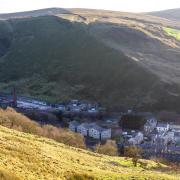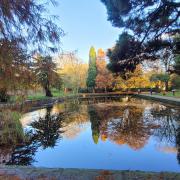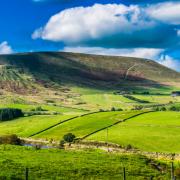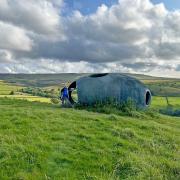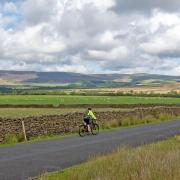Just what drives grown men and women to run up and down the Pennines in all weathers? John Lenehan reveals all
Read John Lenehan's - Fell Walker Routes Blog
I am a 61-year-old fell runner.
I used to be a fell racer and there lies the difference.
Fell racing hurts.
I became a fell racer in 1978 when I gave up playing football. One of my very best mates, Alan Morris, gave up football just before me and took up fell running. Alan was introduced to the sport by Mike Raine, who worked with him at Newmans Footwear in Blackburn.
He suggested I went running with him to get a bit fitter. I remember to this day that first run from Witton Park in Blackburn to the summit of Billinge Hill. I think we ran half way before our legs and lungs gave out but we were hooked and it changed our lives.
Alan and I kept up the attack on Billinge, noting after each run how far we had progressed up its steep paths. There was a wooden bench near the top and one day we ran all the way to it.
We were ecstatic thinking we were fit.
That was until Alan, by now with Clayton-le-Moors Harriers, said there was a fell race from Slaidburn and we should enter. We did and I could not believe human beings could run like that. I was 128th from 150 but at least I wasn’t last and that was the spur. For reasons lost in the mists of time I joined Blackburn Harriers for a few years then moved to Clayton-le-Moors. I have been a member there for 27 years.
Alan went on to greater things than I could ever imagine. He ran the Bob Graham Round, which involves 42 Lakeland peaks, 28,500 ft of climbing and 74 miles in 24 hours. I was more of a single day racer in the shorter, faster events.
The point is that this was all fell racing and it hurts. No matter how fit you are, a run up a fell is hard. You don’t do fell races dressed as a chicken or pantomime horse.
You can be on your own on open moors wading through bogs with just your map and compass in all weathers, or throwing yourself down a mountain track knowing that a trip could mean a very sore landing. You don’t see much more than the person in front or the few feet of track as you try desperately to race and stay upright.
First or last, man or woman, it is tough. You can’t even drop out easily as there are no buses or cars on a fell - just a long weary walk back to the start.
However, the feeling as you reach the finish knowing you have had a good run and beaten your nearest rival is unbelievable. It is pure elation that lasts for hours. I still get it as a racer for Clayton Z Team in the long distance relays, but now it’s just when we beat the Clayton Ladies’ Team.
I became a fell runner when the racing gave way to simply enjoying running on the fells. All the time I was racing I never saw the views. Now I do. The race date used to choose the weather now I can choose the weather. I don’t need to get soaking wet or freezing cold although I often do as I still run locally on three days a week and spend most Mondays on the Lakeland Fells with Keith Butterworth, another Clayton member and good friend.
Fell running, not racing has led to almost 20 years of annual trips to Scotland to run the Munros. Friends Alan Morris, John McGonagle and Ian Mitchell and I have invaded the country every May, to run the magnificent mountains and attempt to empty Scotland’s beer reserves. We are getting better at the latter as we get older. We call ourselves the 4 Musthavbeers for obvious reasons.
Clayton le Moors Harriers weekends were not known for alcoholic abstinence and usually we had one or two pints before our evening meal at the hostel. This was like a flu jab so the body got used to the beer before a full onslaught.
We had fantastic nights in the pubs and a few of us had equally fantastic ways of getting back into the locked hostel after hours. The slight problem was that we had to run back the day after.
In 1998 I helped a Clayton legend, Walt Wilkinson, on a Joss Naylor traverse named after the man himself - one of the greatest fell runners ever. It is a run, designed by Joss when he was 60, from Pooley Bridge at Ullswater to Greendale Bridge in Wasdale. It involves running 30 tops over 48 miles with 17,000 feet of climbing.
I did the second half from Dunmail Raise to Wasdale with Walt, John McGonagle and Richard Wilkinson. It was a tough day for us all but for Walt it was more than we realised. Walt had cancer and died the next year. I, and a lot of Clayton Harriers, still miss Walt and we run a relay in his honour.
I think that all fell runners have one thing in common and that is the love of just being on the fells, moors and mountains. They may not race anymore or run at all but those that can’t will be walking and enjoying the feeling of complete freedom, the moods of the seasons and life itself. And best of all it all comes free.
There are not many things that can bring so much into your life for the cost of a pair of running shoes, shorts and a vest, emblazoned with Clayton-le-Moors Harriers, of course.
Bill Smith - tribute to a fell running great
I cannot write an article on fell running without mentioning the recent sad passing of one of the greats of the sport.
Bill Smith, aged 75, was found dead on Saddle Fell in Bowland. He was a true legend of fell racing and a member of Clayton-le-Moors Harriers. I met him a few times but I didn’t know him well. Donald Barton, who used to be our club President, did know this remarkable chap. He writes:
‘Without doubt Bill was a great fell runner but we saw him as a man who preferred to live life his way. A bit of a loner, it could be said. Bill preferred to have no telephone landline, no mobile phone, no typewriter nor computer. He could be contacted by letter and replied immediately, by return, a hand-written letter.
‘He always used public transport to get from his home in Liverpool to the fell races. He would not ask for a lift, in fact we had to ask him if he wanted a lift and he would then do his best to refuse one. A lad gave Bill a lift only for him to say after they had overtaken a bus to stop so he could get on the now following bus.’
Bill’s book Studmarks on the Summits is now in demand due to its rarity. Donald adds: ‘He was also a photographer and often took photos of runners during races and at some later date, without any fuss, he would give runners their photograph. He was a truly remarkable and unassuming man.’
The print version of this article appeared in the January 2012 issue of Lancashire Life
We can deliver a copy direct to your door – order online here



